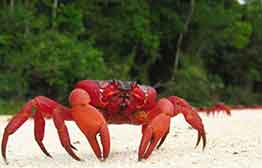A red hot idea to save Christmas Island’s famous red crabs
Every year tourists travel to Christmas Island to see the red crabs’ annual migration, where up to 40 million crabs make the journey from the forest to the sea to mate. In recent years though, super colonies of yellow crazy ants have threatened the crabs.

With around one-third of the island’s crab population being killed by ants over the last 20 years, something had to be done. After years of research La Trobe University and Parks Australia discovered that using a tiny Malaysian micro-wasp as an indirect biological control agent was the answer.
Studies have shown that the micro-wasp (Tachardiaephagus somervilli) will indirectly control the crazy ant super colonies by attacking the introduced yellow lac scale, which supply honey dew, a key food resource for ant super colony formation. Previously the only way to stop crazy ants wiping out Christmas Island’s native wildlife was to use poison bait. However this has proved to only be a short term solution.
Micro-wasps are already used for biological control in mainland Australia, and this approach is fairly common. Due to a range of factors, the researchers proposed a direct release of this species and, in collaboration with the Forestry Research Institute of Malaysia (FRIM), developed a protocol to ensure this could be achieved safely. Over a year ago the department carried out a risk analysis and approved the application to import and directly release the micro-wasps on Christmas Island.
A departmental entomologist travelled to Malaysia in September 2016 to undertake a verification visit of the micro-wasp rearing facility and protocols at FRIM. In December 2016, a departmental entomologist travelled back to Malaysia to inspect and supervise the import of the first consignment of micro-wasps to Christmas Island via Perth.
Biosecurity staff in Perth were prepared for the arrival and holding of the wasps overnight, prior to their onward journey to Christmas Island. The wasps were then released into a rearing facility on Christmas Island, with the first offspring emerging on 29 December 2016.
The wasps will be released onto the island during the next 3-6 months, and will hopefully establish and reduce scale insect populations, improving the outlook for the red crab and helping rebalance the island’s fragile ecology.
This article was reproduced from the newsletter Biosecurity Matters, by the Australian Government Department of Agriculture, Water and the Environment.
